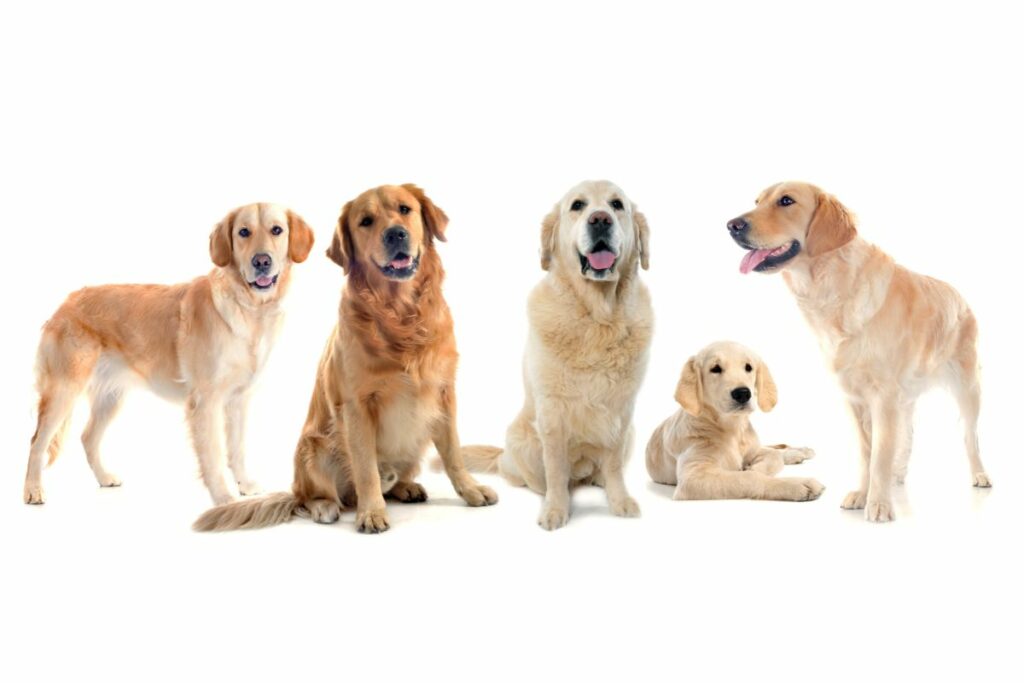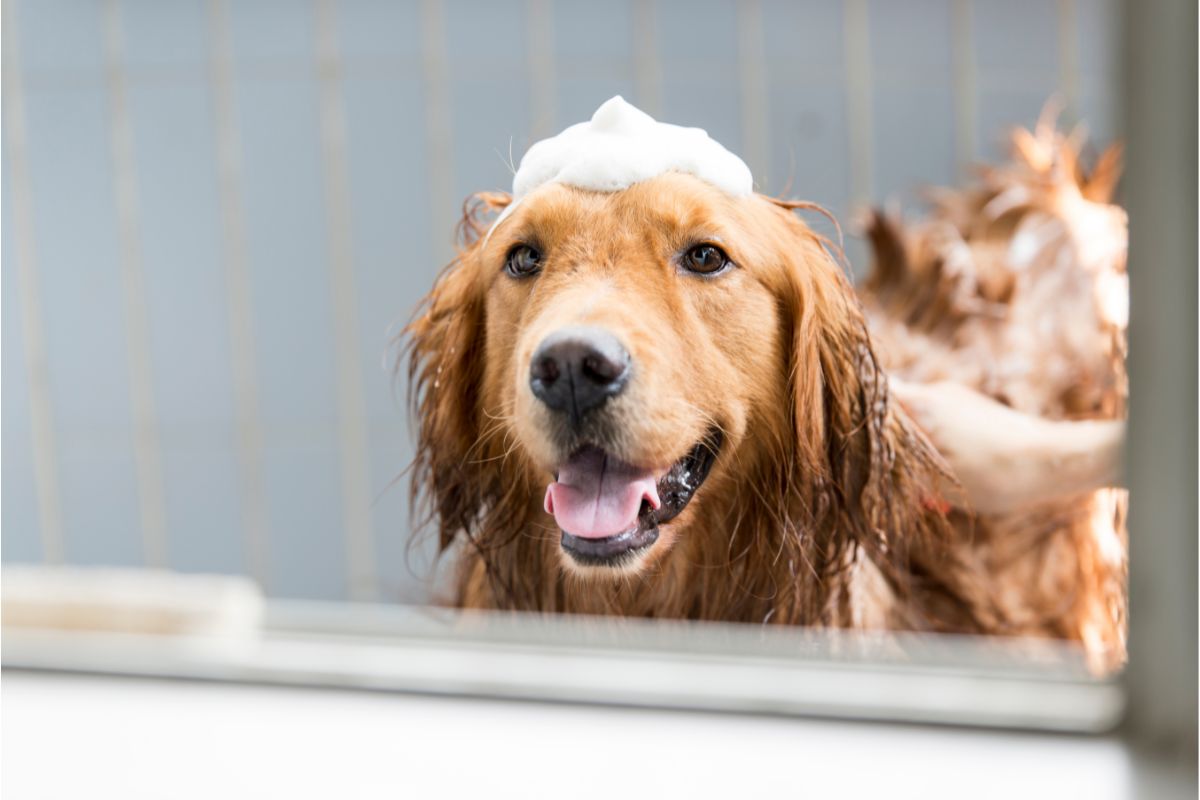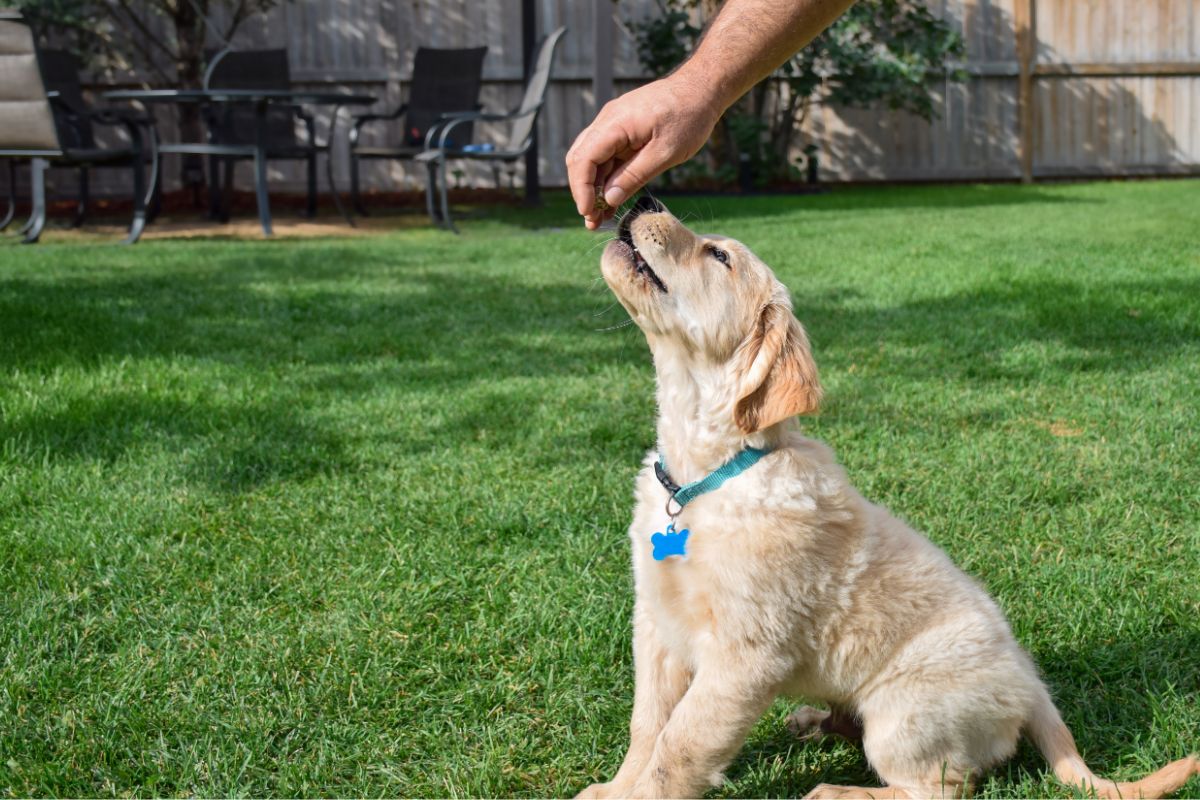Originating from Scotland in the United Kingdom, the Golden Retriever is a breed of dog that was originally bred as a gun dog and is medium in size.
Known for its beautiful flowing golden coat, its ancestors were the Tweed Water Spaniel and the Wavy-Coated Golden Retriever – both of which are now extinct.
Widely accepted as a great family dog, the Golden Retriever is renowned for being friendly and kind.

Their intelligence and sociability make them one of the most popular breeds to train as service dogs.
In fact, this breed is so popular that the American Kennel Club (AKC) advises that these dogs are the 4th most popular in America!
Golden Retrievers come in a variety of colors on the glorious golden spectrum, of which three are recognized by the AKC (though some will argue that there are up to eight variations).
In this guide, we’ll look a little more at different colored golden retrievers.
Prepare yourself for cuteness overload!
What Determines The Color Of A Golden Retriever?
What determines the fur color of the Golden Retriever?
The black gene (eumelanin) and the red gene (pheomelanin) are the primary influencers of coat color.
Specifically, the way that gene sites B (the black colorway), E (yellow tones), and C (affecting the lightness/darkness of the golden tone) are constructed will determine what color your furry friend is.
When it comes to dog shows, the AKC advises in their Official Standard for the Golden Retriever that, despite there being the three recognized shades of Golden Retriever, a predominant body color that’s super pale or super dark isn’t as desirable as some other variants.
It’s interesting to note that within the same litter, a puppy’s shade of golden can vary from the lighter end of the spectrum to the darker end of the spectrum.
As puppies grow into adult dogs, the shade of golden that they are can also change.
A Closer Look At Different Colored Golden Retrievers
Now, let’s take a closer look at the three main coat colors.
Light Golden Retrievers

Sometimes referred to as “English Cream Golden Retrievers” or “Rare White European Golden Retrievers”, these beautiful dogs have a coat which can look almost white to the human eye.
However, these descriptions are not necessarily accurate representations of their true heritage nor of their true rarity or color.
All Golden Retrievers descended from their Scottish ancestors and are now bred widely in the Western world.
Where this breed is bred does not impact the color of the dog – this is down to genetics which affects the pigmentation.
In terms of rarity, whilst marketed as a “rare” breed, no evidence substantiates these claims.
Despite not being as rare as breeders attempt to depict, these popular pups are considered to be unique, and it’s true that they may be less common than the classic Golden Retriever, which has resulted in their ever-growing popularity.
Despite appearing white at times, a Golden Retriever’s coat will never be truly white.
Specifically, the AKC categorizes these light Retrievers as light-golden – code 119.
In terms of genetic coding, these lighter pups will specifically have the “cc” pairing in the “C” region.
Golden Retrievers

Sometimes referred to as a Classic Golden Retriever, this is the kind of Golden Retriever most people will visualize when thinking of this breed.
As the name suggests, their lustrous fur is a beautiful Golden blonde color.
Bella is a pretty classic golden color whereas Dante is a little lighter (though not quite white).
In terms of temperament, as with both of the other shades of Goldens, these furry pals are considered to be friendly, loving, and intelligent.
Their lively but gentle nature makes them a great breed to introduce to a family with children.
Having said that, these traits are not specific to the Classic Golden Retriever, as their Lighter and Darker counterparts are also known to be similar in personality.
The AKC categorizes the Classic Golden Retriever as “Golden” – code 093. Their genetic coding in the “C” region will show up as “Cc”.
Dark Golden Retrievers

These deeper colored Goldens often (but not always) have an almost auburn hue to their fur.
Sometimes referred to as a Red Golden Retriever, these pups are often a little smaller in comparison to their Light Golden and Golden counterparts, though as with any dog, this also comes down to the genetic lines.
The fur length will also often be ever so slightly shorter than those dogs who are on the lighter end of the spectrum within the breed, making their fur less prone to tangling than Light Golden and Golden Retrievers.
Despite this, it is still important for dog owners to maintain a regular grooming routine, as well as trimming of the fur that is not on the main body of the dog.
Many have wondered where such a deep red shade in the Golden Retriever has come from. Some people have considered that the bloodline of these Retrievers could contain Irish Setter, although there is no evidence to support this statement.
Their registered code in the AKC is 080 – Dark Golden. In terms of genetic makeup, the “C” region of the Dark Golden Retriever will show up as “CC”.
The Final Woof
There are three main Golden Retriever colors, according to the AKC. These are the light golden, the classic golden, and the dark golden.
Whatever color your Golden Retriever is, one thing is for certain – they are super cute!
Don’t forget to groom your pooch regularly to keep that gorgeous golden coat in tip-top condition.
Frequently Asked Questions
Red Retrievers are generally considered to be the most rare although Retrievers on the paler side can also be considered rare.
This is subjective, and can pretend on your personal preferences. In terms of dog shows, the classic golden coat is considered to be the most desirable color. But we think all colored Golden Retrievers are equally gorgeous.








